|
22
September 2005
Pete
Goss returns to the Maritime Museum in Falmouth on
Wednesday 19 October 2005 for a third and final lecture
about his incredible Team Philips project. This is the
last opportunity to listen to the inspirational and
charismatic speaker that has already given two sell-out
talks to a captivated audience.

A
tired Pete Goss December 2000 said
the
vessel was "quite fantastic"
Pete Goss first caught the public imagination with his
dramatic rescue of French sailor Raphael Dinelli in the
1996 Vendee Globe. All year, the Museum has been
featuring a fascinating exhibition about his last
adventure, Team Philips, and Pete will be inspiring
others to 'dare to dream' with his talk on this epic
West Country project.
Team Philips was built to be the biggest, fastest and
most hi-tech of boats. With wave-piercing bow technology
she was specifically designed for The Race - a no-holds
barred, no limits, round the world challenge. A global
community was drawn together in support of this
extraordinary project; 97 million people visited the
website, 1.2 million people passed through the visitor
centre and 9,212 people signed up to become individual
sponsors.
Reflecting on Team Philips Pete said: "Progress is
about change and development; by definition, attitudes
will always follow one step behind. By accepting the
risks we chose to drive in the fast lane. Defeat,
however, sometimes has to be accepted. As a team we can
look the project in the eye knowing that we gave it our
all. We dared to dream and we are proud of what we
achieved."
2005
to See Team Philips Exhibit - September 07, 2004
National
Maritime Museum Cornwall is delighted to announce that
its major exhibition for 2005 will be a celebration of
Team Philips.
Team
Philips was the dream of one man, Pete Goss, who
inspired millions. Pete and his team developed the
revolutionary catamaran that was Team Philips. A 120ft
long, 70ft wide (larger than the centre court at
Wimbledon) and 135ft high (taller than ten Double Decker
buses) catamaran that owed more to aerospace than boat
building. The team, the boat and their combined spirit,
entered the hearts, minds and emotions of hundreds of
thousands of people all over the world. Now the Maritime
Museum is developing a dedicated exhibition celebrating
this West Country epic project.
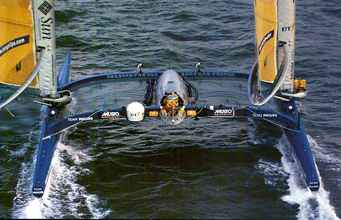
Team
Phillips at sea
Team
Philips was built to be the biggest, fastest and most
high-tech of boats. With wave piercing bow technology
she was a sailing spaceship in carbon fibre, and was
specifically designed for The Race – a no-holds
barred, no limits, round the world challenge.
In
December 2000, on the passage to the start of The Race
in Barcelona, Team Philips had to be abandoned in freak
weather. 70 knot winds, 10m waves and worsening weather
conditions, left Pete and his crew no choice but to
abandon Team Philips or risk their lives.
40ft
of the original 120ft starboard hull was salvaged off
Iceland. Carrying thousands of names of individual
supporters it will form the centre piece of the
exhibition. The museum has been working with Pete
collecting objects, photographs, equipment and other
memorabilia which will all play a central role in this
exciting exhibition.
Pete
Goss comments: “I wanted to preserve the ‘spirit’
of Team Philips and the Museum is the perfect setting.
Some might say the project was a failure, so why
celebrate it? But, you can’t measure success just by
winning, it can be measured in so many ways and I know
Team Philips inspired others to go the extra distance,
to overcome their fears and to tackle their own
challenges. Granny Barney, for example, who at 60 walked
the south coast of England to raise £10,000 for her
church and Team Philips, is a prime example of the drive
and determination that can make anything possible –
and that’s why we called the galley after her.”
Pete
continues: “Progress is about change and development;
by definition, attitudes will always follow one step
behind. By accepting the risks we chose to drive in the
fast lane. Defeat, however, sometimes has to be
accepted. As a team we can look the project in the eye
knowing that we gave it our all. We dared to dream and
we are proud of what we achieved and I am over the moon
that the museum will be telling this story.”
The
support for the project was enormous, with 1.2m visitors
passing through the visitor centre in Totnes and a
further 97m hits on the website. Team Philips is the
story of an entire community; how an amazing group of
people pulled together for the adventure of a new
millennium and a celebration of that achievement.
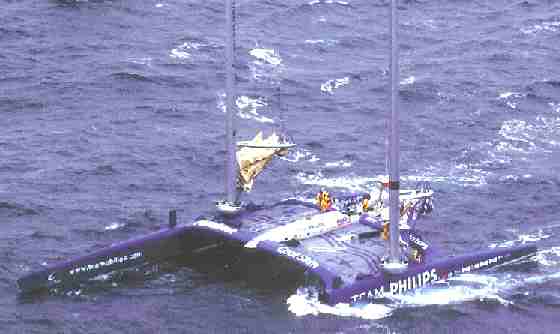
News
UK
Friday, 17 August, 2001
Wreckage
of superyacht found
Part of the Team Philips catamaran abandoned in stormy
Atlantic seas has been discovered 90 miles west of the
Shetland Islands. A salvage operation is now underway to
recover a section of the yacht which skipper Peter Goss
and his crew were forced to abandon last December.
Coastguards spokesman Mark Clark
Coastguards
said a survey vessel working in the Foinaven oil and gas
fields spotted the wreck. They
believe the wreck is a substantial part of the
revolutionary carbon fibre super yacht.
Recovery
underway
A
joint operation by recovery crews from Britain and the
Faroe Islands is under way, according to British
Maritime and Coastguard Agency spokesman Mark Clark.
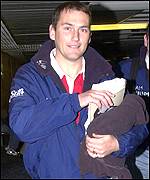
The
survey vessel GEO Pacific, which spotted the wreck, has
pulled up alongside it, awaiting assistance. A Faroe
Islands coastguard vessel, the Brimil, is due to arrive
by midnight to tow the catamaran back to Thorshavn in
the Faroe Islands, Mr Clark said.
"The
survey crew spotted the debris and it was clear from
markings and the colour that this was a large section of
Pete Goss's catamaran. "We want it out the way
because if it is blown towards shore or nearby fishing
nets it could pose a danger to smaller vessels.
"The lump is ... large enough to show up on
radar."
Final
blow
Earlier
in the year, some wreckage from the £4.5m vessel was
found 25 miles off the Irish north Mayo coast. The loss
of the superyacht, which was built in Totnes, Devon, was
the final blow for the troubled project.
During
her first sea trials off the Scilly Islands, one of her
bows snapped off and during later tests problems
developed with one of her masts. In December, while
undergoing final preparations out in the Atlantic for
The Race, cracks developed in her accommodation pod.
After
a battle to escape ferocious winds and huge waves, the
crew were forced to abandon the revolutionary £4m
catamaran.
After
the loss of the boat, the companies Goss Challenges Ltd
and Goss Composites Ltd, set up in Totnes, found
themselves in financial difficulties and were
voluntarily wound up in April this year. A friend of
Goss said that the yachtsman was on holiday and had no
comment about the discovery.
Thursday,
4 January, 2001
Goss
unveils new ocean mission
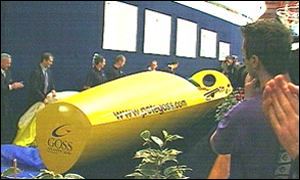
Pete
Goss's new project aims to break rowing records
Yachtsman
Pete Goss has unveiled his latest ocean racer less than
a month after his Team Philips catamaran project ended
in disaster. His new venture, a futuristic rowing boat,
will be aimed at smashing trans-Atlantic records,
although Goss will not be part of the four-man crew.
Goss revealed the carbon fibre Atlantic Spirit at the
London International Boat Show at Earls Court. The Goss
Atlantic Row project's Atlantic Spirit hopes to crack
two records when the four-man crew, led by former Royal
Marine Mark Stubbs, takes the oars of the 10-metre craft
in June.
The
crew aim to break two records - the 35 day Atlantic
rowing record currently held by 11 Frenchmen, and the 55
day west to east crossing. The catamaran Team Philips
was dramatically lost in the north Atlantic in early
December and just three days before Christmas a tearful
Goss announced the end of his bid to race the
revolutionary craft around the world.
The
sailor's latest vessel, Atlantic Spirit, was built at
the Totnes, Devon complex where Team Philips was
created.
Carbon
fibre
The
lightweight craft - just half the weight of her four-man
crew - is built of carbon fibre like the ill-fated catamaran
and is the brainchild of the same designer, Adrian
Thompson. It is a self-righting craft with a watertight
crew accommodation area in case of bad weather. In
coming weeks the Goss team hopes to launch Atlantic
Spirit in Devon and begin trials for the Atlantic record
bid.
The
crew members have been in training for the attempt but
have not yet rowed together.
Crew
leader Mark Stubbs said: "We have got the
commitment and desire to win and to take on the
Atlantic". He added: "Pete has turned this
into a reality and now given us the tool to do the
business with." Stubbs and his crew plan to start
their 2,100 mile voyage from St John's, Newfoundland, to
the Isles of Scilly, off west Cornwall, in June.
Friday,
15 December, 2000, 16:19 GMT
Goss
refuses to admit defeat
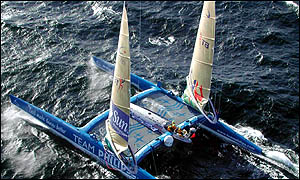
Pete Goss is refusing to admit defeat in his attempts to
sail his revolutionary Team Philips boat around the
world. On Sunday,
Goss and his crew abandoned their £4m ($5.8m) catamaran
in the middle of the Atlantic ocean.
Team
Philips was supposed to be part of Bruno Peyron's
round-the-world race, which leaves at the end of the
month. His loss
will be a significant blow to the organisers.
Rescue
"It
was a very traumatic time for everyone," said Goss,
who is back in Britain. "But there is no way we are
going to make any judgement on the future yet. "We
don't act on scenarios, we act on fact and at the moment
we don't have any facts, so we will have to wait and
see."
The
crew were forced to climb aboard the Hapag Lloyd
container ship in the middle of a storm which saw 70ft
waves force the yacht against the side of the rescue
vessel. At one point, the 130ft mast came within four
feet of hitting Graham Gough as he climbed up the
lifeline thrown from the Hapag Lloyd.
Goss,
though, defended his boat, the world's largest racing
catamaran, and a project that has been plagued with a
string of problems. "If it wasn't for that boat, we
would not be here now, it is as simple as that,"
added Goss. "It stood up to everything we asked
for.
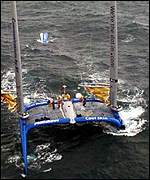
A
sorry sight: The bow broke in sea trials
Pete Goss
"The
reason why we made the decision to abandon ship was
because my responsibility is to the crew and I felt
that, with the freak weather, they were at risk.
"The pod which housed us was not part of the
primary structure of the boat but it was this part of
Team Philips which was causing the problems.
"Cracks were opening up which threatened the
integrity of the secondary structure, which housed the
crew, but the primary structure stood up to the
conditions superbly. "The first thing I am going to
do now I am back is to go and see the engineers and
designers and thank them for their efforts, for without
them we would not be here."
First-class
team
Goss
must hope the costs of the salvage operation currently
underway do not destroy his budget and end any hopes of
a future attempt. "I cannot answer how much it will
cost because we have only just arrived back and don't
know anything yet," he said. "We know where
she is and that is about it. Until we have got to her
and assessed the damage, we can't be certain of
anything. "We will need to carry out a survey to
see if she can ever go to sea again, but it is certainly
not the end of this team, which is nothing short of
first class."
Friday,
15 December, 2000
Revolutionary
catamaran 'saved our lives'
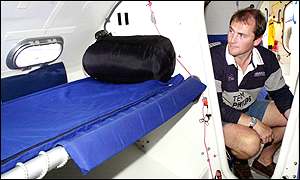
Pete
Goss inspects the accommodation pod before the final
trip
The
crew of the stricken superyacht Team Philips would not
be alive today if it were not for the radical design of
the vessel, according to her skipper Pete Goss. The
catamaran's crew arrived back in Britain on Friday, just
days after their terrifying rescue from stormy Atlantic
seas. After a futile eight-hour battle to escape
ferocious winds and huge waves, the crew were forced to
abandon the revolutionary £4m catamaran when a section
of the vessel was smashed.
Speaking
after their arrival at Heathrow Airport at 0700GMT, Mr
Goss said the storm was the worst he had experienced.
But he said: "We wouldn't be here if we weren't on
Team Philips."
Mr
Goss, who came up with the idea of the catamaran's
design, refused to speculate on its future. But he
insisted the team involved in the Team Philips project
did have a future.
"The
key to this project is the people and we have a future.
We're not beaten, far from it."
Perfect
performance
The
superyacht, which is 120ft long and 70ft wide, was
planned and built by a team of designers and craftsmen
at Totnes in Devon, and was intended to travel at speeds
of up to 40 knots. It was also the largest carbon-fibre
structure in the world and cost about £4m to construct.
About 80 cars could be parked next to each other between
the two hulls. One
of the most radical aspects of the vessel's design was
her twin unsupported wingmasts.
With
no stays attached, there was nothing to hold the giant
structures in place but the strength of the hull itself.
Each mast was subjected to a force similar to that
experienced by the wing of a jumbo jet. On Friday, Mr
Goss said that despite the eventual outcome, the
catamaran had performed perfectly. "Every little
bit of work that went into that boat was tested in that
storm. She was quite fantastic," he said.
'Rogue
waves'
"We
were trying to create a vessel that is a generation
ahead and we have done it," he said.
"We
were in the unknown. No one had ever been in those
conditions in a catamaran, it was very frightening. The
raw energy was quite extraordinary."
The
storm, a severe depression known as a "bomb",
had not been forecast, said Mr Goss.
"Rogue
waves", which had moved so quickly they could not
be distinguished from clouds, had crashed across the
vessel, finally damaging the accommodation pod and
endangering the lives of those on board. The skipper
praised the captain of the German container ship, the
Hoescht Express, which rescued the seven-strong crew
more than 750 miles west of Ireland.
"He
handled that ship like a dinghy," he said.
Despite
Mr Goss's vigorous defence of the catamaran, she was
plagued by setbacks following her launch by the Queen
in March. In her first outing, part of the craft's bow
snapped off prompting concerns that its radical design
may have been flawed. She was re-launched having
undergone £250,000 of repairs and strengthening, but a
second sea trial in October ended after just a few hours
when the vessel suffered a mast problem.
Thursday,
16 November, 2000
Giant
catamaran back at sea
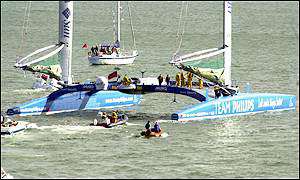
Team
Philips is afloat again
The
world's largest pure carbon structure, a giant
catamaran is back on the water after overcoming the
latest in a series of setbacks. The 120ft vessel,
called Team Philips, is the size of the centre court
at Wimbledon and cost £4m to build. It was unveiled
by the Queen in March but suffered a series of
accidents during sea trials.
In
its first outing, the craft's bow snapped off
prompting concerns that its radical design may have
been flawed. During the second trial, its masts
developed problems forcing the crew to return to port
in Dartmouth. The yacht was towed to skipper Pete
Goss's boatyard in Totnes, Devon, where engineers
discovered the damage was superficial and successfully
repaired it.
'Ready
for The Race'
Victoria
Williams, of Team Philips, said they were now
preparing for the event known as "The Race"
- a round the world event which starts in Barcelona,
Spain, next January. "The small hiccups we have
had are just the kind of teething problems which you
will always get with a prototype.
"The
boat will do the talking now and we will be able to
show just what she can do," she said.
But
there have been concerns about safety. One crew member
left last month saying Team Philips was not ready to
compete in The Race. But Team Philips' skipper, Pete
Goss, has insisted it is up to the challenge. The
catamaran will be setting out on more sea trials early
next week.
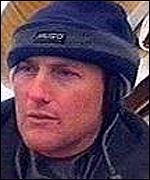
Pete
Goss says vessel is up to The Race
|










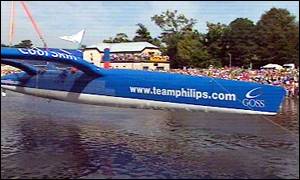
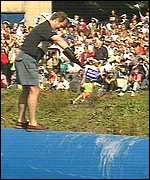
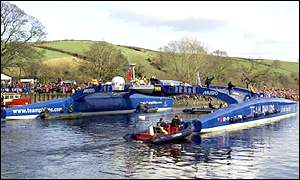
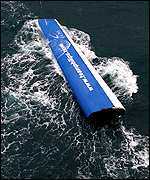
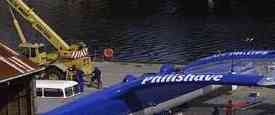
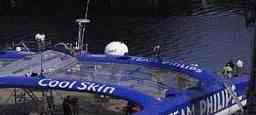
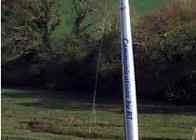

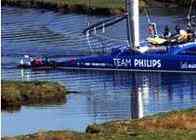
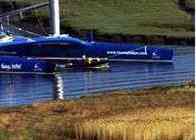
![image: [ Pete Goss - another award to honour his bravery ]](images/pete_goss_family_1998.jpg)